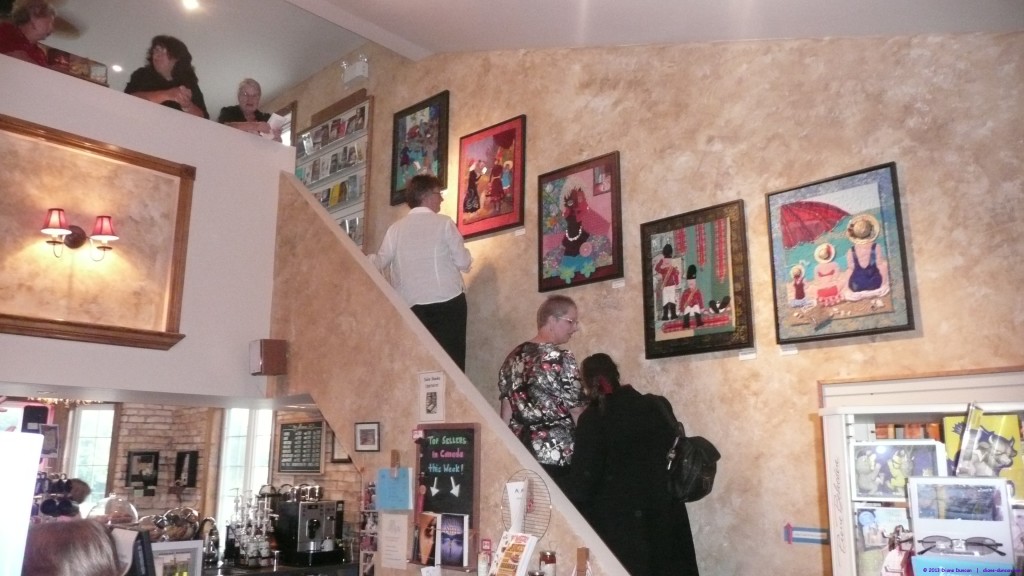Exhibitions – Learning How to Proceed

This is from one of my first competition and art shows and I received a ribbon and prize money for second in my class!
One of the my groups in Calgary has had some really interesting professional development discussions at the meetings. We each take a turn hosting and leading a meeting each year. My turn comes up in March and I’m starting my research.
Although I have participated in many group shows and have continued to do so throughout our travel years, I have only had a couple of solo shows and they preceded our travel departure date in 2009 so I need to refresh my thinking on exhibitions and how to proceed.
I thought that instead of gathering my notes for personal use only, I would share my learning about exhibiting artwork through a series of blog posts with links to my sources. I’m going to start with a summary of my key points gleaned from some 2012 posts by Anna Hergert, on of Canada’s leading fibre artists. Her blog posts are wonderful – and useful. Be sure to check out the original posts at the links I provide as she tells a story around the following points that puts the information into context.
Anna, in her post “Moving toward Exhibition part 1 talks about how to focus your preparation for an exhibition. She suggests:
- Start with a specific idea or area of research for this new body of work;
- Select a theme and create a working title;l
- Develop a list of words for inspiration;
- Collect images, make sketches, doodles, and any information you can find pertaining to the subject matter.
- Identify possible colour schemes
- Audition some fabrics, dye or paint some fabrics for use
- Consult your art journals, sample books, idea files
- Make notes of ideas, designs, dreams – anything that comes to mind throughout this process.

The response to one of my pieces in this show led to the creation of a series of pieces and a solo show.
In her second post on the topic, she talks about how to prepare for mounting an exhibition. Anna suggests:
- BEGIN. The first piece often doesn’t make it into the exhibition as colours and themes may shift between the first piece and the last;
- Identify galleries that might be interested in your subject matter and medium. In a later post she talks about how to approach a gallery but this post is about how to proceed with developing your series of pieces for exhibition;
- Once you are successful in booking a show, investigate the size of the gallery by getting a floor plan of the gallery that provides information about the linear footage for displays. Visit the gallery if possible to get a feel for the atmosphere, lighting etc.
- Determine the number of pieces to hang, allowing for two feet between each piece. Divide the number of pieces required by the number of months before the show, less one month allowance for final preparation of pieces for hanging and to gain some perspective on the pieces for the show;
In the third post she talks about how to deal with the emotions associated with mounting an exhibition. Anna suggests:
- Keep your focus and don’t give in to self-doubt and FOMO (Fear of Missing Out – a new term for me). Avoid distractions, establish a routine and schedule, manage time spent on emails, phone, web surfing – however you procrastinate.
- If you are unsure of your ability to mount a show, start by working with a group or with another artist. The encouragement gained can be helpful. For a solo show, identifying a mentor may be helpful.

My first solo fibre art show – Sometimes the ‘gallery’ presents hanging challenges!
In the fourth post Anna talks about how to approach a gallery.
- Before submitting a proposal, investigate several galleries. Identify for each one – their focus and when they accept/review proposals. Most galleries review proposals during a set time during the year and often with a two year lead time.
- Have a concrete idea and several pieces completed. Gallery owners like to see actual pieces of recent work.
- Submit a professional proposal that includes:
- A cover letter which includes a brief outline of what the exhibition entails (1 page max).
- Your CV (curriculum vitae) including your education, exhibition experience (solo and group), awards and grants, publications, lists of organizations supported through membership and board appointments. (2 pages max).
- Your biography (1 page max)
- Your artist’s statment specific to the proposed exhibition (3 paragraphs/ 1 page max)
- A CD with 20 professional images labeled with a sequential number and title of work. (I like to use with last name_first name_title_number). The CD should be labeled with your name, your address and the title of the proposed exhibition.
- A detailed list of images corresponding to the CD with title of work, medium, measurements, year completed.
- A stamped self-addressed envelope so the gallery can return the portfolio if they are not interested in your work.
Anna suggest that each page should be printed on letterhead which includes your full name, full mailing address, web site URL, phone number, and email address. She also suggests that everything be enclosed in a presentation portfolio with a postcard (photo) of your work on the cover.
Anna also suggests that after submission, you follow-up with a phone call or an e-mail to ascertain arrival of the proposal. Be patient. After two months, inquire if a decision has been reached and, if possible, try to find out the reason for rejection. This info can be useful for future proposals. Anna also says to remember – many submissions and rejections before the acceptance of a proposal is quite normal. Don’t take it personally!
